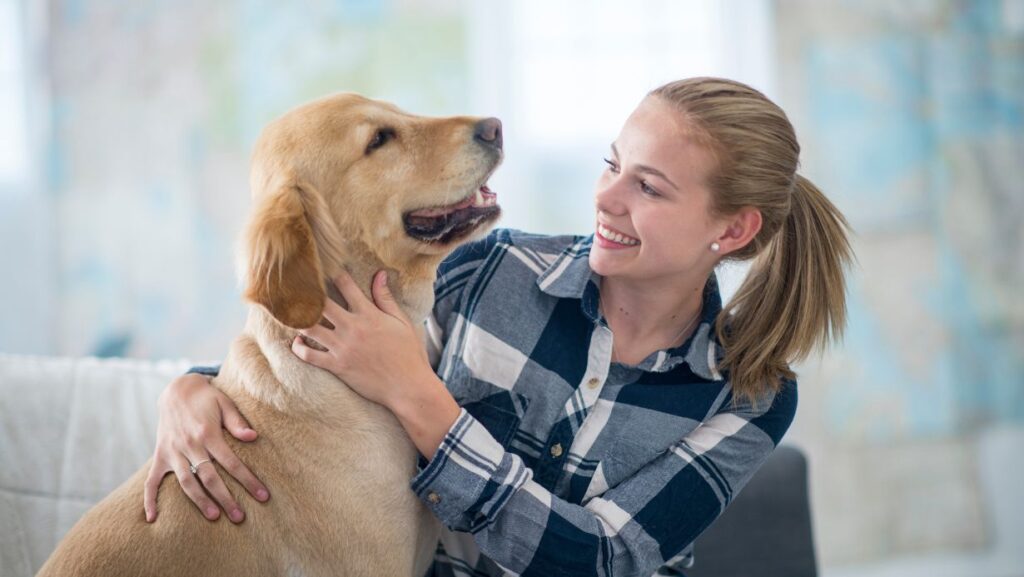We know that owning a dog can bring a lot of joy, but it can also bring with it lots of questions. Between meal times, vet visits and exercise needs, there’s a lot to consider when taking care of your pup. That said, there are some questions that come up time and time again from both new and experienced doggo owners. So what are these commonly asked dog-related queries? Read on to find out!
Contents
- At what age should I start training my dog?
- What are the most effective methods for potty training a dog?
- How can I stop my dog from barking excessively?
- How can I get my dog to obey my commands?
- How can I socialize my dog with other animals?
- What should I do if my dog is displaying aggressive behavior?
- How can I keep my dog healthy and happy?
- What should I do if my dog gets lost or injured?
- In Summary
At what age should I start training my dog?
Training dogs begin from the day they set foot in your home. It is important to start as soon as possible and to be consistent with all members of the family. Training your dog should also include socialization, which teaches them how to appropriately interact with other animals, friends and strangers.
Young puppies can begin basic obedience commands such as sit, stay and come when called. These commands create an early bond, a foundation for further training, address any behavior issues from an early age and build trust between you and your pet.
It is best to start training your dog at 8 weeks old, or whenever you receive them (like in rescue cases). Dogs reach emotional maturity slower than humans so behaviors may not change overnight. For example, puppies need to learn that jumping up on visitors is not polite or acceptable – this takes time and consistency but they will eventually understand the correct behavior more quickly if they are trained correctly from the beginning.

What are the most effective methods for potty training a dog?
Potty training can be an arduous and difficult process, especially if you are a first-time dog owner. Although it requires patience and persistence, success can be achievable. Here are a few common methods to potty train your dog:
- Establish a routine: Establish a schedule for feeding, walking, and potty times so that your dog gets used to being taken out at certain times. Set regular potty times throughout the day, such as every four hours to start off with. Make sure your pet doesn’t have access to water between these breaks so that he knows when he needs to go.
- Crate Training: Crate training is an effective way to help puppies learn where they should properly eliminate in the house since dogs don’t like to soil their own sleeping quarters. Make sure the crate is not too large so that your dog won’t have enough room for both sleeping and elimination within it; instead, consider getting another larger crate for resting purposes only after your pup has become accustomed to their designated elimination zone within the smaller crate.
- Reward-based Training: Offer rewards like treats or verbal praise when he goes in his assigned area quickly and correctly—this will reinforce the behavior you want him to develop over time.
- Supervise Your Dog: Whenever you take your pet outdoors for potty time, make sure you stay with them until they relieve themselves in the correct spot—avoid distractions like playtime or petting before or after going outdoors as this may prolong or confuse your pup’s learning process of where they should formulate their eliminations at home versus outside of it—Best practice is use their pee pad areas both inside and outside of home if applicable otherwise only focus on outdoor training first once focused then move on introducing indoor pee pad areas.
- Clean Up Accidents Promptly: Clean up any accidents immediately as this will help prevent future accidents from happening as poop/urine odors may encourage dogs to go back again in that same spot—optimal cleaning materials would be odour neutralizers like white vinegar mixtures vs store bought enzyme cleaners since they do not leave any residual scent trails behind.
How can I stop my dog from barking excessively?
Excessive barking can be an annoying problem for some dog owners. Understanding the reasons why your dog may be barking is a crucial part of solving this problem. Generally speaking, dogs bark in order to communicate something.
If a dog barks when someone enters the home or when they hear a specific sound, the barking may be due to anxiety; if your dog barks when playing with you or other pets it is usually due to excitement.
In order to stop your dog’s excessive barking, you should first try and identify what is causing the issue and address any underlying issues.
If you cannot determine why your pup is barking excessively, there are several methods that can help decrease their behaviour including positive reinforcement, counter-conditioning, and desensitization techniques.
Positive reinforcement works by rewarding good behavior such as staying quiet when asked; while counter conditioning involves teaching the pup new behaviors like shaking a toy or sitting quietly in response to triggers such as loud noises or people entering their space.
Desensitization involves exposure to the fear-causing stimulus or triggers along with paired positive reinforcement over time until they learn to remain calm while exposed to it. It’s important never to yell at your pet or punish them harshly for barking excessively as this can cause further emotional distress in them, leading them even further away from overcoming their fear-based triggers that contribute towards their excessive vocalizations – always practice patience and kindness!

How can I get my dog to obey my commands?
Getting your dog to obey your commands requires a combination of consistent positive reinforcement and clear communication. Dogs are most likely to do as they are told if they understand what you want them to do.
Spend time training your dog using positive reinforcement (such as treats and verbal praise) until they understand basic commands. When you give commands such as “sit” or “stay,” make sure that the words are complete sentences—speak with authority and be precise in your language.
Set expectations for the behaviors you want from your dog, and then work towards building strong, lasting relationships with them. You can also try enrolling in an obedience class with a professional trainer which will help build positive habits with your pup!
Socializing your dog with other animals is an important part of being a responsible pet owner. It can help them become more comfortable in public and less likely to react aggressively when encountering other animals. To properly socialize your dog, start with positive reinforcement.
Make sure to reward them for good behavior and be patient while they learn how to interact safely with other animals. Depending on the size of your dog and the environment in which you live, some of the best ways to socialize include taking them for regular walks in public spaces, setting up play dates with friends or family who have dogs for companionship or finding a local doggy day care to give them exposure to other pets over short periods of time.
Be sure that all interactions are supervised by someone who can read their body language, and that any aggression is firmly corrected. With enough patience, you should easily be able to find activities that will expose your pet to outside stimuli without putting either party in danger!
What should I do if my dog is displaying aggressive behavior?
Dogs can display aggressive behaviors for a variety of reasons including fear, anxiety, territorial issues or illness.
If your dog is exhibiting aggressive behaviors, the following steps should be taken:
- Identify possible causes and triggers for the aggressive behavior. Common causes include physical pain, illness or emotional stress.
- Create a safe environment- remove potential objects of aggression such as toys and treats, and provide plenty of space to avoid physical contact with you or other pets in the house.
- Re-establish trust through positive reinforcement – find activities that you enjoy together and compliments his good behavior with treats, praise or favorite activities such as walks or outdoor time.
- Train calmly- stay calm when addressing unwanted behaviors and resist correcting in an angry manner as it can cause more leverage on aggression tendencies
- Consider professional help – if these initial steps do not work, it may be beneficial to consult a professional behaviorist who is experienced in helping owners manage aggressive behavior in their pets.
How can I keep my dog healthy and happy?
Dog owners can ensure their pet’s ongoing health and wellbeing by providing meals that are suitable for their life stage, regular exercise, and seek out veterinary care at the first sign of any illness or symptom. Besides these daily essentials, there are other ways to help your pup stay happy and healthy.
- Regular Grooming: Regularly brushing your dog’s coat will not only help keep it clean, but it will also reduce shedding. In addition to this, daily grooming helps to monitor any changes in your dog’s skin or fur that could indicate a medical condition.
- Mental Stimulation: Mental stimulation is just as important as physical exercise for dogs. Providing plenty of opportunities for breed-appropriate play and activities is a great way to encourage your dog’s mental wellbeing – both indoors and out!
- Dental Health: Good dental hygiene can prevent dental disease from becoming a problem in the future and can also improve your pet’s overall health. Make sure you brush your dog’s teeth regularly with a toothbrush specifically designed for dogs (never human toothbrushes!), as well as provide healthy chew toys or other items designed to massage their gums and remove plaque build-up on teeth surfaces
- Quality Nutrition: Giving them the right food is essential for maintaining their health over the long term, particularly during puppyhood and senior stages of life where special attention should be paid to dietary composition requirements. To make sure they get all of the nutrients they need, do research on what type of food would best meet their dietary needs based on their size, breed type, lifestyle etc., and stick with high quality nutrition like Hill’s Science Diet which has been tailored specifically towards various life stages of dogs making it easy to select one necessary for yours! Monitor weight change, and energy levels frequently when assessing food adequacy so that you can make timely adjustments if required.
- Socialization Training: Proper socialization is extremely important for puppies in particular – those between 8 weeks – 12 weeks old – during which period in the developmental period learning socially appropriate behaviors must happen – it is how a pup learns how best interact with everyone from humans through family members all the way cross-species. Schedule group training sessions or one on one private training lessons teach basic commands like sit stay fetch etc., then graduate toward more advanced obedience work – It will help keep them mentally agile!
What should I do if my dog gets lost or injured?
If your dog goes missing, it’s best to take action right away and contact the local animal control center or humane society. They may have information about lost animals in the area, or can provide advice about the best methods for finding your pet. Be sure to create ‘lost pet’ flyers with a clear picture of your dog, its name and any distinguishing characteristics.
Most importantly – do not give up hope! Many dogs are reunited with their owners each year through grassroots efforts such as flyers, social media posts and word of mouth. In certain cases, you may want to consider hiring a professional pet detective who specializes in helping people find lost pets.
If your dog is accidentally injured, it is important to seek veterinary attention immediately. If you have pet insurance then you can be worry-free about the costs involved, but you must have a basic understanding how pet insurance works. Pet insurance is an important form of protection for pet owners since it helps to offset the cost of medical care when illness or unexpected accidents occur. It is an easy way to reduce or even eliminate worry about the high cost of veterinary services.
In Summary
In general, the pet insurance contract will provide coverage for accidents, illnesses, surgeries and other specified treatments. Depending on the plan you choose, additional benefits may be provided, such as prescription drug coverage or alternative therapies including acupuncture, chiropractic care and behavioural therapy. Most policies pay a portion of costs incurred up to a maximum limit each year. Premiums are typically paid monthly and vary according to each state’s regulations.
Remember that if there was any sort of pre-existing condition prior to getting pet insurance, this may not be eligible for coverage under certain policies; make sure you check properly before deciding to get pet insurance.
